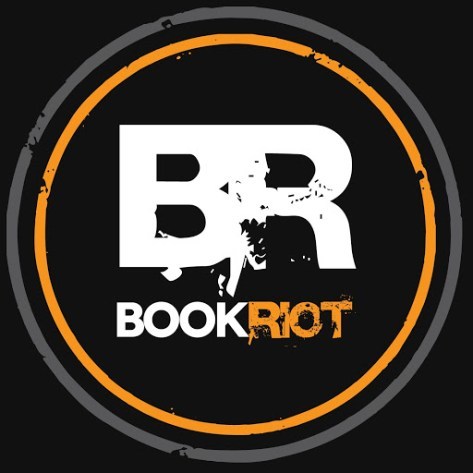Kelly Jensen's Blog, page 22
January 16, 2020
This Week at Book Riot
This week at Book Riot…
A new piece of legislation in Missouri could make censorship of public library materials easier.
Literary threads for plus size bodies at Torrid.
Check out the increase of visible disability representation on YA book covers in 2020. I cannot wait to share Body Talk’s cover, which also include visible disability.
It’s my week to be on All The Books, and I talked about four incredible books — fiction, nonfiction, and YA — that you should pick up this week.
January 14, 2020
Graphic Novel Roundup
2019 was a great year for middle grade graphic novels. Here are two recent ones I enjoyed and will often recommend to kids, particularly when their favorites aren’t on the shelf.
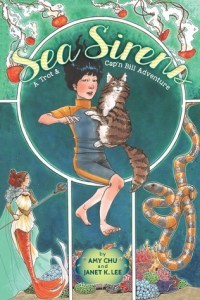 Sea Sirens: A Trot and Cap’n Bill Adventure by Amy Chu and Janet K. Lee
Sea Sirens: A Trot and Cap’n Bill Adventure by Amy Chu and Janet K. LeeVietnamese American surfer girl Trot is surfing with her cat, Cap’n Bill, when she’s pulled beneath the waves into the sea kingdom below. There, Cap’n Bill’s ornery nature manifests in an unexpected way: he can now talk! Trot and Cap’n Bill find themselves caught up in a battle between the Sea Siren mermaids and the Serpent King. Even if they survive, will they be able to make it back to the surface, where Trot’s ailing grandfather waits for them? What’s more – will Trot even want to?
This is a graphic novel after my own heart. I’ve written before about how I learned to read in part from The Wizard of Oz, and its influences upon Amy Chu and Janet Lee’s book are easily noticed. (In fact, it was directly inspired by one of Baum’s other stories, The Sea Fairies, which started out as separate from Oz, but later overlapped.) Kids who have read a few of the Oz novels beyond the first may recognize Trot and Cap’n Bill from The Scarecrow of Oz, Baum’s ninth book in the series, who originally appeared in The Sea Fairies and whose names Chu borrows for her story. Lee’s character designs and costuming are reminiscent of the illustrations by John R. Neill, who illustrated most of the Oz series, including recognizable hairstyles and headpieces. Her vivid art lends itself well to the myriad strange and curious creatures Trot finds in the sea kingdom, creatures with which Oz fans will feel right at home. And the story uses one of the most popular fantasy tropes that Baum visited frequently – that of a girl swept away to a magical land, where animals can talk and adventure awaits. Chu infuses Vietnamese mythology into her story, effectively blending multiple points of inspiration into a unique and compelling graphic novel. A sequel, Sky Island, is due out this summer.
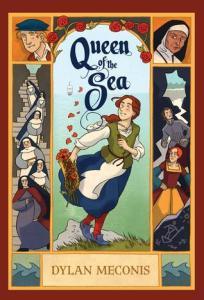 Queen of the Sea by Dylan Meconis
Queen of the Sea by Dylan MeconisMeconis’ book is something a bit different from the usual middle grade graphic novel fare. For starters, it’s alternate historical fiction – based upon the childhood of Queen Elizabeth I – that even adults may find difficult to parse without some research or an author’s note. It’s also quite long at almost 400 pages. This may not be a book a kid (or even an adult) could finish in a single sitting. But for the right kind of reader, the ones who like their stories a bit slower and more contemplative, who are fascinated by the past and how different people used to live, this will hit the spot.
The star of Queen of the Sea is Margaret, an orphan who lives in a convent on a tiny island off the coast of Albion. Her only companions are the nuns who run the convent – some kind, some not – and a boy around her own age, William. Then a mysterious woman arrives, and though her identity is supposed to be a secret, Margaret learns that she is Eleanor, the exiled queen of Albion. Eleanor’s arrival throws Margaret’s life into upheaval, revealing secrets about the convent and bringing the world beyond the island very close to home.
Meconis takes her time with her story, fully developing Margaret and her place on the island, as well as her relationships with the nuns, before bringing in Eleanor to shake things up. Margaret’s relationship with Eleanor is particularly fascinating, both in terms of how they interact with each other and how close Margaret discovers her own story is to Eleanor’s. The world-building is a real treat for historical fiction fans, peppered with little details about what life was like at a convent in the 16th century (for example, the many different times of day the nuns – and Margaret – were required to pray, and what each time for prayer was called). Meconis complements her intriguing, slow burning story with muted full-color art in a mostly realistic style, occasionally breaking away for asides in which Margaret explains convent life to the reader. These parts are reminiscent of an illuminated manuscript in style, a nice touch that adds to the sophistication and design of the entire work of art.
January 12, 2020
Early 2020 Nonfiction For Young Readers
It’s the season of lists in the book blogosphere, isn’t it? We’ve moved from favorites and bests of the last year and we’re all now onto the most anticipated of the new year. That’s not a slight on either, but rather an opportunity to see what sorts of books get attention and which ones fall a bit through the cracks.
Nonfiction for young readers — that 10-18 range, which spans both middle grade readers and teen readers — always seems to be one of the categories that doesn’t land on a whole lot of lists. I suspect part of it has to do with the fact these books are still not as widely publicized or reviewed as their fictional counterparts, part of it has to do with the fact it’s a bit of a strange age-range, part of it has to do with the stigma around nonfiction for young readers being “report books” still, and part of it has to do with the fact that many YA-centric reviews/blogs/publicity avenues ultimately cater to the adult reader of YA, as opposed to the young reader. Again, not a slight.
Young readers are the target market of nonfiction for young readers. How the word about these books spreads is just different.
One of the things that makes this category of books so special and has for the better part of the last decade is that they’re inclusive. They showcase a wide range of stories, of insights, and of perspectives.
Let’s take a look at some of the nonfiction for young readers hitting shelves in the early part of 2020. This won’t be a comprehensive list. It’s challenging to know where these books are published, and it’s also challenging to differentiate between books which are meant to help students with research projects and those meant to be more leisure reading without looking at them first hand.
All descriptions are from Goodreads, as are publication dates. As always, publication dates can shift and change. Note, too, that these books cover a slightly different age range that typical YA books. Some will skew a little younger and encompass middle grade readers. I have also included nonfiction comics on the list.

Early 2020 Nonfiction For Young Adults
January
Almost American Girl by Robin Ha (1/28)
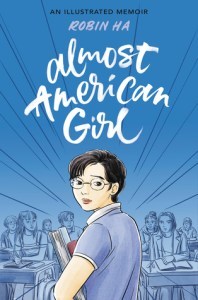
For as long as she can remember, it’s been Robin and her mom against the world. Growing up in the 1990s as the only child of a single mother in Seoul, Korea, wasn’t always easy, but it has bonded them fiercely together.
So when a vacation to visit friends in Huntsville, Alabama, unexpectedly becomes a permanent relocation—following her mother’s announcement that she’s getting married—Robin is devastated. Overnight, her life changes. She is dropped into a new school where she doesn’t understand the language and struggles to keep up. She is completely cut off from her friends at home and has no access to her beloved comics. At home, she doesn’t fit in with her new stepfamily. And worst of all, she is furious with the one person she is closest to—her mother.
Then one day Robin’s mother enrolls her in a local comic drawing class, which opens the window to a future Robin could never have imagined.
Flowers In The Gutter by K. R. Gaddy (1/7)
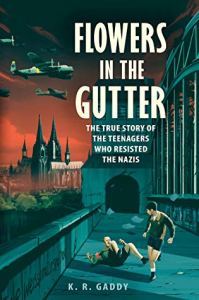
Flowers in the Gutter is told from the points of view Gertrude, Fritz, and Jean, three young people from working-class neighborhoods in Cologne, beginning with their pre-school years at the dawn of the Third Reich in the 1930s. Gaddy shows how political activism was always a part of their lives and how they witnessed first-hand the toll it took on their parents–and how they still carried the torch for justice when it was their turn.
Once the war began, Gertrude, Fritz, and Jean and their friends survived and even resisted in one of the most heavily bombed cities in Germany. Gaddy includes tense accounts of fights with Hitler Youth and the Gestapo, of disseminating anti-Nazi pamphlets, of helping POWs and forced laborers, and even of sabotaging Nazi factories.
Ultimately, the war ended tragically for several young pirates, and Gaddy shows how post-war politics and prejudices led to these young men and women being branded criminals for decades after the war.
Say Her Name by Zetta Elliott (1/14)
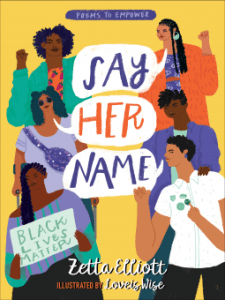
Say her name and solemnly vow
Never to forget, or allow
Our sisters’ lives to be erased;
Their presence cannot be replaced.
This senseless slaughter must stop now.
Award-winning author Zetta Elliott engages poets from the past two centuries to create a chorus of voices celebrating the creativity, resilience, and courage of Black women and girls. Inspired by the #SayHerName campaign launched by the African American Policy Forum, these poems pay tribute to victims of police brutality as well as the activists championing the Black Lives Matter cause. This compelling collection reveals the beauty, danger, and magic found at the intersection of race and gender.
Stolen Justice: The Struggle For African American Voting Rights by Lawrence Goldstone (1/7)
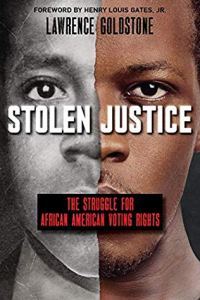
Following the Civil War, the Reconstruction era raised a new question to those in power in the US: Should African Americans, so many of them former slaves, be granted the right to vote?
In a bitter partisan fight over the legislature and Constitution, the answer eventually became yes, though only after two constitutional amendments, two Reconstruction Acts, two Civil Rights Acts, three Enforcement Acts, the impeachment of a president, and an army of occupation. Yet, even that was not enough to ensure that African American voices would be heard, or their lives protected. White supremacists loudly and intentionally prevented black Americans from voting — and they were willing to kill to do so.
In this vivid portrait of the systematic suppression of the African American vote, critically acclaimed author Lawrence Goldstone traces the injustices of the post-Reconstruction era through the eyes of incredible individuals, both heroic and barbaric, and examines the legal cases that made the Supreme Court a partner of white supremacists in the rise of Jim Crow. Though this is a story of America’s past, Goldstone brilliantly draws direct links to today’s creeping threats to suffrage in this important and, alas, timely book.
Where’s My Stuff? by Samantha Moss, Lesley Martin, and illustrated by Michael Wertz (1/7)

Helps to learn how to organise your school stuff, your time, and your room. This book includes: notebook systems; backpack maintenance tips; practical pointers for managing your schedule; a template for your own personalised daily planner; and, interior design-inspired techniques to make your room your favourite place to be.
You Too? edited by Janet Gurtler (1/7)
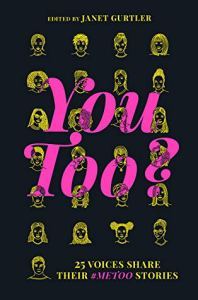
A timely and heartfelt collection of essays inspired by the #MeToo movement, edited by acclaimed young adult and middle-grade author Janet Gurtler. Featuring Beth Revis, Mackenzi Lee, Ellen Hopkins, Saundra Mitchell, Jennifer Brown, Cheryl Rainfield and many more.
When #MeToo went viral, Janet Gurtler was among the millions of people who began to reflect on her past experiences. Things she had reluctantly accepted—male classmates groping her at recess, harassment at work—came back to her in startling clarity. She needed teens to know what she had not: that no young person should be subject to sexual assault, or made to feel unsafe, less than or degraded.
You Too? was born out of that need. By turns thoughtful and explosive, these personal stories encompass a wide range of experiences and will resonate with every reader who has wondered, “Why is this happening to me?” or secretly felt that their own mistreatment or abuse is somehow their fault—it’s not. Candid and empowering, You Too? is written for teens, but also an essential resource for the adults in their lives—an urgent, compassionate call to listen and create change.
February
Jane Against The World: Roe v. Wade and The Fight for Reproductive Rights by Karen Blumenthal (2/25)
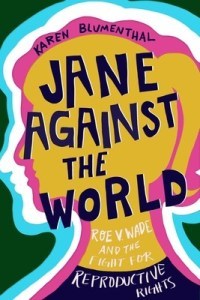
Tracing the path to the landmark decision in Roe v. Wade and the continuing battle for women’s rights, Blumenthal examines, in a straightforward tone, the root causes of the current debate around abortion and repercussions that have affected generations of American women.
This eye-opening book is the perfect tool to facilitate difficult discussions and awareness of a topic that is rarely touched on in school but affects each and every young person. It’s also perfect for fans of Steve Sheinkin and Deborah Heiligman.
This journalistic look at the history of abortion and the landmark case of Roe v. Wade is an important and necessary book.
The Rise and Fall of Charles Lindbergh by Candace Fleming (2/11)

First human to cross the Atlantic via airplane; one of the first American media sensations; Nazi sympathizer and anti-Semite; loner whose baby was kidnapped and murdered; champion of Eugenics, the science of improving a human population by controlled breeding; tireless environmentalist. Charles Lindbergh was all of the above and more. Here is a rich, multi-faceted, utterly spellbinding biography about an American hero who was also a deeply flawed man. In this time where values Lindbergh held, like white Nationalism and America First, are once again on the rise, THE RISE AND FALL OF CHARLES LINDBERGH is essential reading for teens and history fanatics alike.
March
Apollo 13: A Successful Failure by Laura B. Edge (3/3)
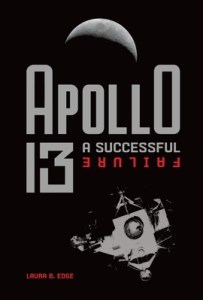
“Houston, we’ve had a problem.”
On April 13, 1970, the three astronauts aboard the Apollo 13 spacecraft were headed to the moon when a sudden explosion rocked the ship. Oxygen levels began depleting rapidly. Electrical power began to fail. Astronauts James Lovell, Jack Swigert, and Fred Haise were about to be stranded in the inky void of outer space.
The mission to the moon was scrapped. Now, Apollo 13‘s only goal was to bring the crew home. With the damaged spacecraft hurtling towards the moon at roughly six thousand miles per hour, there was little hope of success. But the astronauts and mission control were fully prepared to do whatever it took to return the crew to Earth.
This space disaster occurred at the peak of the United States’ Space Race against the Soviet Union. But for four days in 1970, the two nations put aside their differences, and the entire world watched the skies, hoping and praying the astronauts would return safely. As missions to Mars and commercial space flight become a reality, the time is now to be reminded of our common humanity, of how rivals can work together and support each other towards a shared goal. Because no matter what happens or where we travel, we all call Earth home.
Earth Day and the Environmental Movement: Standing Up for Earth by Christy Peterson (3/3)
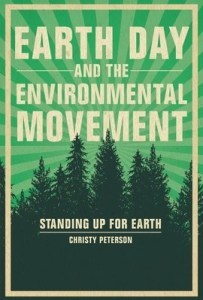
On April 22, 1970, an estimated twenty million people held in a teach-in to show their support for environmental protections. This new celebration, Earth Day, brought together previously fragmented issues under the same banner. It was the largest nationwide event ever, and lawmakers took notice.
But one day didn’t change everything. Fifty years after the first Earth Day, climate change remains a dire concern. The divide between political parties continues to widen, and environmental policy has become an increasingly partisan issue. The spread of disinformation has also made climate change a debatable idea, rather than scientific fact. A new generation of advocates continue the fight to make environmental policy a top priority for the United States and for nations around the globe.
The Fire Never Goes Out by Noelle Stevenson (3/3)
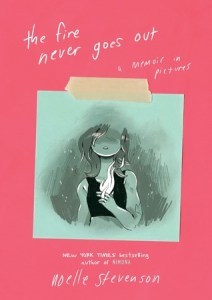
In a collection of essays and personal mini-comics that span eight years of her young adult life, author-illustrator Noelle Stevenson charts the highs and lows of being a creative human in the world. Whether it’s hearing the wrong name called at her art school graduation ceremony or becoming a National Book Award finalist for her debut graphic novel, Nimona, Noelle captures the little and big moments that make up a real life, with a wit, wisdom, and vulnerability that are all her own.
Fly Like A Girl: One Woman’s Dramatic Fight in Afghanistan and on the Homefront by Mary Jennings Hegar (3/3)
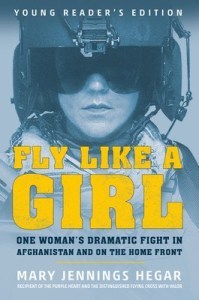
On July 29, 2009, Air National Guard Major Mary Jennings Hegar was shot down while on a Medevac mission in Afghanistan. Despite being wounded, her courageous actions saved the lives of her crew and their patients, earning her the Purple Heart as well as the Distinguished Flying Cross with Valor Device. That day also marked the beginning of a new mission: convincing the U.S. Government to allow women to serve openly on the front line of battle for the first time in American history.
With exclusive photographs throughout, Fly Like a Girl tells the inspiring true story of Mary Jennings Hegar–a brave and determined woman who gave her all for her country, her sense of justice, and for women everywhere. Includes exclusive photographs throughout, a discussion guide, and a Q&A with the author written specifically for teen readers.
Stamped: Racism, Antiracism, and You by Jason Reynolds and Ibram X. Kendi (3/10)
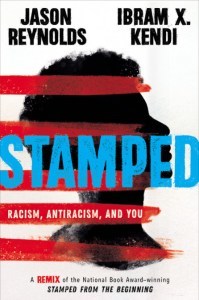
This is NOT a history book.
This is a book about the here and now.
A book to help us better understand why we are where we are.
A book about race.
The construct of race has always been used to gain and keep power, to create dynamics that separate and silence. This remarkable reimagining of Dr. Ibram X. Kendi’s National Book Award-winning Stamped from the Beginning reveals the history of racist ideas in America, and inspires hope for an antiracist future. It takes you on a race journey from then to now, shows you why we feel how we feel, and why the poison of racism lingers. It also proves that while racist ideas have always been easy to fabricate and distribute, they can also be discredited.
Through a gripping, fast-paced, and energizing narrative written by beloved award-winner Jason Reynolds, this book shines a light on the many insidious forms of racist ideas–and on ways readers can identify and stamp out racist thoughts in their daily lives.
April
All Boys Aren’t Blue by George M. Johnson (4/28)
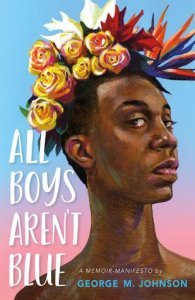
In a series of personal essays, prominent journalist and LGBTQIA+ activist George M. Johnson explores his childhood, adolescence, and college years in New Jersey and Virginia. From the memories of getting his teeth kicked out by bullies at age five, to flea marketing with his loving grandmother, to his first sexual relationships, this young-adult memoir weaves together the trials and triumphs faced by Black queer boys.
Both a primer for teens eager to be allies as well as a reassuring testimony for young queer men of color, All Boys Aren’t Blue covers topics such as gender identity, toxic masculinity, brotherhood, family, structural marginalization, consent, and Black joy. Johnson’s emotionally frank style of writing will appeal directly to young adults.
Dancing at the Pity Party by Tyler Feder (4/14)
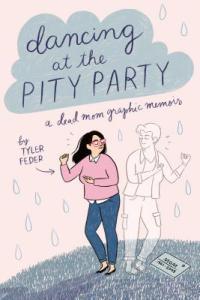
Part poignant cancer memoir and part humorous reflection on a motherless life, this debut graphic novel is extraordinarily comforting and engaging.
From before her mother’s first oncology appointment through the stages of her cancer to the funeral, sitting shiva, and afterward, when she must try to make sense of her life as a motherless daughter, Tyler Feder tells her story in this graphic novel that is full of piercing–but also often funny–details. She shares the important post-death firsts, such as celebrating holidays without her mom, the utter despair of cleaning out her mom’s closet, ending old traditions and starting new ones, and the sting of having the “I’ve got to tell Mom about this” instinct and not being able to act on it. This memoir, bracingly candid and sweetly humorous, is for anyone struggling with loss who just wants someone to get it.
In Good Hands: Remarkable Female Politicians from Around The World by Stephanie MacKendrick (4/14)

Written for young women interested in running for office, this book is unlike any other, with inspiring stories of eighteen women role models along with the all the tools and resources needed to get a campaign off the ground.
Stephanie MacKendrick, a former journalist now dedicated to women’s career advancement, believes the time for women in political leadership is now. Judging by the recent wave of activism that developed into a flood of women seeking elected office, she’s not alone.
MacKendrick has created a one-of-kind insider’s guide for young women interested in joining this movement and becoming part of the political system. It explores everything from what to expect in a campaign, to how to deal with the inevitable challenges, to why it’s A truly original book about running for office written specifically for young women, with inspiring stories of eighteen role models who took the plunge, and all the tools and resources needed to get a campaign off the ground.
No matter where you live or who you hope to represent, the experience of running for office is different if you are a woman. This one-of-a-kind insider’s guide is perfect for young women who are ready to make change. It combines uplifting stories of women from around the world who have run for office with practical advice for anyone who wants to follow in their footsteps. It explores everything from what to expect in a campaign, to how to deal with the inevitable challenges, to why it’s worth it to run.
One Earth: People of Color Defending Our Planet by Anuradha Rao (4/7)
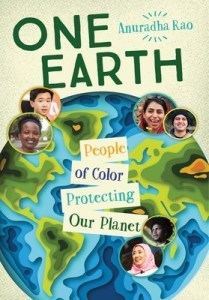
One Earth profiles Black, Indigenous and People of Color who live and work as environmental defenders. Through their individual stories, the book shows that the intersection of environment and ethnicity is an asset to achieving environmental goals. The twenty short biographies introduce readers to diverse activists from all around the world, who are of all ages and ethnicities. From saving ancient trees on the West Coast of Canada, to protecting the Irrawaddy dolphins of India, to uncovering racial inequalities in the food system in the United States, these environmental heroes are celebrated by author and biologist Anuradha Rao, who outlines how they went from being kids who cared about the environment to community leaders in their field. One Earth is full of environmental role models waiting to be found.
January 9, 2020
This Week at Book Riot
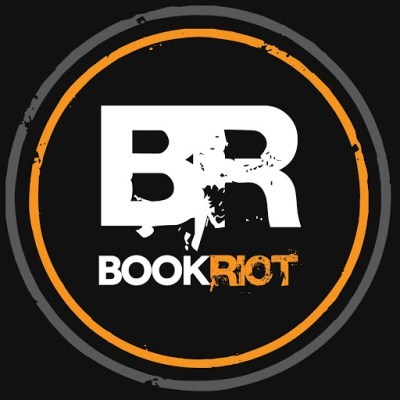
Over on Book Riot this week…
Excellent
170+ YA books hitting shelves in the first quarter of 2020. Bulk up that TBR!
All of the sweary notebooks to help you kick ass this year.
There’s also a new episode of Hey YA. Eric and I talk about our reading goals for the year, along with some of our most anticipated new reads. Oh, and we have an announcement: the show will be going weekly! You’ll have to tune in to see what those new episodes will sound like.
January 7, 2020
The Parker Inheritance by Varian Johnson
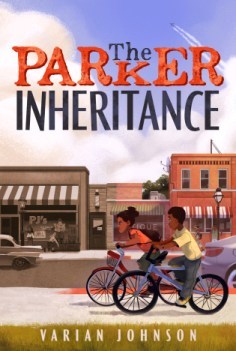
One of my most cherished memories from my childhood is reading The Westing Game by Ellen Raskin with my mother. We kept a little notebook, sized for little hands, where I would write down all of the clues from Mr. Westing’s will and everything else that was revealed along the way. I still remember the way I felt when I put the clues together into a a very big clue that led me to the big reveal – before Turtle herself had figured it out! I loved the wordplay and the puzzles and the fact that Raskin made solving this one achievable for a kid like me.
The Westing Game likely wasn’t the first mystery I read, but it certainly spurred my lifelong love for them. I still get a thrill every time I figure out a mystery on my own, whether it’s in a book, a game, or a play. Of course, nothing quite matched the magic of that first experience with The Westing Game.
Enter Varian Johnson and The Parker Inheritance. I was lucky enough to see Johnson, a local Austin author, speak at an event recently, which convinced me to finally pick up my copy of The Parker Inheritance and give it a read. I was so delighted the whole way through. The Parker Inheritance is a mystery predominantly based on puzzles and riddles contained within a letter from an eccentric individual who has recently died, much like Raskin’s Newbery winner from 1978. Reading it brought back the joy I experienced when reading The Westing Game, but this is no imitation. Johnson has created a unique mystery that feels fresh and modern, one that kids will love trying to solve alongside his protagonists.
Candice Miller and her mom – recently separated from her dad – are staying in Candice’s grandmother’s old home in Lambert, South Carolina while their home is renovated. Candice’s grandmother died a short while ago, but she was infamous in Lambert for digging up historic tennis courts to try and find treasure underneath (none was found). She lost her job as assistant city manager because of it.
When Candice is exploring the attic, though, she finds a letter addressed to her grandmother, a letter that explains why she would have done such a seemingly inexplicable thing as dig up a treasured community space in the middle of the night without any permission or authorization. The letter tells of an old injustice done upon the family of a young woman named Siobhan Washington, and how the letter writer planned to visit justice upon the culprits. The letter writer has hidden a great treasure somewhere within Lambert for the person who can find it, and everything needed to figure out the mystery is contained within the letter itself. Candice’s grandmother tried and failed; Candice is determined to finish the job.
After a rocky start, she teams up with Brandon Jones, the boy across the street, and the two set about solving the mystery involving a Black family (the Washingtons) who lived in the segregated town of Lambert in the 1950s. Johnson’s novel tackles the racism Siobhan and her family experienced then as well as the racism Candice and Brandon (who are also Black) experience even now, pitching everything perfectly to a middle grade audience. The Washingtons’ story is heartbreaking, full of twists and turns and surprises that are revealed slowly as the kids figure out the series of clues. Johnson peppers the book with flashbacks, first to the patriarch of the Washingtons when he was a child of sharecroppers in the early 1900s, then to the events of the 1950s, where the bulk of the story takes place, and finally to the decades afterward, where readers learn about the rippling effects of everything that happened.
The Parker Inheritance is such a fun book that doesn’t sacrifice depth. Candice and Brandon are well-realized characters that readers will root for, and their sadness and horror and anger at discovering what happened to Siobhan and her family will mirror young readers’. Readers will be able to follow the clues as Candice and Brandon discover them; some may even figure out some vital information before they do! Johnson’s story has a lot to say not only about the ingenuity of kids, but also about racism, human nature, forgiveness, and revenge. The later chapters focusing on the decades after the tragedy of the 1950s were my favorite: bittersweet and lovely and ultimately hopeful. This is a book that can be read on multiple levels; the luckiest readers will understand it on all.
Personal copy
January 6, 2020
Books That Are Helping Me Right Now
On December 23, my grandma passed away peacefully. I was there with her, along with my mom, as well as two of my mom’s friends. She was 83, and up until two weeks prior, had still been working and driving and never needed any help getting around.
To say it happened swiftly and shockingly is an understatement.
My grandma was like a parent to me. I lived with her and my grandfather from the time I was in kindergarten until I graduated high school. This loss has been, and continues to be, like that of losing a parent.
Christmas was a lot sadder this year, though we all did the best we could. We knew we’d all be getting back together again in a few days to plan, and then attend, a funeral.
I did a lot of driving back and forth the second half of December, between my home and my mom’s, about an hour and a half away. I quickly realized being in silence was the furthest thing from helpful for me. I also realized that trying to rush any feelings or grief, trying to wrap up any loose ends or be fully available for anyone else at the drop of a hat, simply wasn’t possible.
I needed instead to give myself space to breath and space to feel.
The day before she died, I had a suspicion that there wouldn’t be a miracle. She wouldn’t want any intervention, and she’d certainly have been angry to know what state she was in at the end. I prepared myself both by giving myself said space and by seeking out books which might be helpful in the immediate days and weeks following her passing.
I’m not religious. I tried a number of areas of belief and nothing’s quite gelled with me. I have, however, found yogic philosophy and Buddhist philosophies to align closest to my mindset, both as we are here as people, as well as in what might lie for us after death. I wanted a book or two that would come at loss from these perspectives, as I am comfortable there, as well as comfortable navigating the areas which don’t resonate with me in some way.
I got a number of great recommendations from fellow readers, as well as from those who aren’t necessarily readers but who have themselves experienced big loss. Here’s what I picked up and what’s been especially helpful for me.
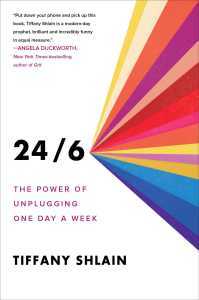 24/6 by Tiffany Shlain
24/6 by Tiffany ShlainWhat would a book about unplugging from the online world for a day have to do with grief and loss? I wouldn’t have ever expected this book to me what helped me in those most tender moments during my driving, but it did.
Shlain’s book is about her family’s practice of a tech Shabbat. Each Friday evening, the entire family unplugs and shuts down all technology so they can focus on doing things that require no tech. This means planning out travel routes prior to Friday night to print directions or making use of an old-school map if they forget or choose to travel elsewhere. It means no cell phones but reliance on a landline in the event there’s an emergency.
About 2/3 of the way through the book, though, Shlain — who performs the audiobook herself — starts to talk about losing her father. She talks about how important having time with her husband and kids without the noise of the rest of the world was. This hit me so hard, and it was a powerful reminder to be there with my grandmother in the hospital.
The discussion of grief and loss here was surprising, and it tapped something deep in me. Both because I felt everything Shlain was talking about and because it reminded me how precious or time really is and how saying no to screens for a measly 24 hours can really and truly make an impact on your relationships.
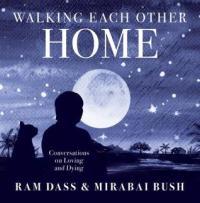
Walking Each Other Home: Conversations on Loving and Dying by Ram Dass and Mirabai Bush
Christmas week had something in the air, as Ram Dass passed the day before my grandma did. I began to dig into his teachings earlier this year, thanks to my 500-hour teacher training modules, and it felt right to pick up this book.
This isn’t a typical narrative nonfiction title. Instead, it’s a series of conversations held between Bush and Dass about what happens after we die. Dass, whose life was completely changed after a stroke, had done a lot of thinking about death and what comes after, and Bush talks with him about our spirits and where they go once we leave our bodies.
We fear death because we don’t know it, and Dass walks through getting to know what death is and how to come to peace with the fact it happens to us all at some point, as well as to everyone we love. He talks about how to sit with the dying, as well as how to grieve, and I found so much comfort in how my grandmother’s death happened, as well as the choices we made as a family afterward.
I love the idea that death is the beginning of a new type of relationship. There’s something extremely comforting in that, and it’s been a rock in my grieving. I can feel and experience the sadness, but I can also have a relationship with my grandma in a new and different way. I can’t call her on the phone or hear her laugh again, but I can see her in many new, different ways and that will never go away until I do.

True Refuge: Finding Peace and Freedom In Your Own Awakened Heart by Tara Brach
I’ve read Tara Brach before — her Radical Acceptance is a great primer for Buddhist teachings for those who have no knowledge of them. But I picked this one up because it seemed like a good one to pair with the Dass book and I wasn’t wrong. I popped this on audio and listened during my drives.
Brach’s book is about the ways we find refuge when life gets hard. We can find true refuge, which requires getting real with your experiences, your emotions, your actions, and your thoughts. We can also find false refuges, which are tools we use to feel better but don’t actually help us feel better (think: alcohol, eating, etc). Through meditations, examples, and practices, Brach digs into how we can cultivate the true refuge within us.
The idea of letting what is be is simple, conceptually, but in practice, it’s hard as hell. This was a reminder that that’s important to do, though, as it’s a practice in understanding suffering and non-attachment. Being able to get radically present with anything, especially grief, is a hard-earned gift but it’s been a buoy to me.
Other Books On My Pile
I haven’t gotten to everything I want to read, and chances are good that I’ll seek out more books as the rawness begins to smooth a bit more. Here’s what’s on my pile — if you’ve got other recommendations akin to these, I’d love to hear them. I’d prefer not to read about the dying process or memoirs about loss but rather, the deeper philosophical/spiritual side of things.
*When Things Fall Apart: Heart Advice for Hard Times by Pema Chödrön
*Yoga for Grief: Simple Practices for Transforming Your Grieving Mind and Body by Antonio Sausys
*It’s OK That You’re Not OK: Meeting Grief and Loss in a Culture That Doesn’t Understand by Megan Devine
December 31, 2019
Cybils Spiderweb 2019 (updated)
Another Cybils season has come to an end (at least, my role in it has). Later today, the finalists my team chose in the YA speculative fiction category will go live. I’m excited to see readers’ and authors’ reactions, and I’m also eager to see which books made the cut in other categories. To celebrate, I added to the Cybils Spiderweb I created a few weeks ago, updating it with more books and more connections. I hope you enjoy perusing it as much as I enjoyed creating it.
December 22, 2019
My Favorite Books of 2019
I’m so glad I didn’t write my favorite books post earlier this month because one of my favorite reads came very recently. I’m glad I don’t have to skip including it, since it’s one that got a bit of buzz but maybe not as much as it should, and certainly not in the format I read it. I’ve listened to a significant number of audiobooks this year, and while some of my favorite audio titles will be included here, I’ll pull together a list next week with some of my favorite listens of 2019.
This list includes books I read this year which published this year. I read a lot of back list titles, especially in audio, but I wanted to put the spotlight on the newer titles. My final tally on books will likely be in the neighborhood of 190, which is about what my reading averages tend to be every year. These are in alphabetical order by title and cover a little bit of everything: YA, literary fiction, and nonfiction.
I could have easily doubled this list, but I limited myself to just ten.
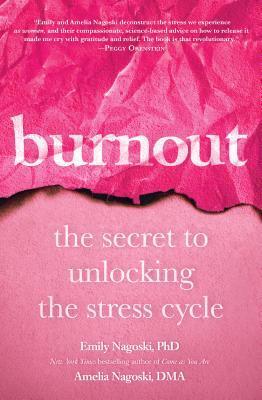 Burnout: The Secret to Unlocking The Stress Cycle by Emily and Amelia Nagoski
Burnout: The Secret to Unlocking The Stress Cycle by Emily and Amelia NagoskiIf there’s one book I recommended more than any other in 2019, it was this one. I listened to it on audio and while I cannot recommend that experience enough — these sisters are so great at performing their work! — I think this is a book I’ll go back and purchase in print because I want to be able to reference it.
Let me begin by saying that, if you know anything about how stress works on the body, you won’t be surprised at the information in this book. But it’s the way the Nagoskis are able to explain why we need to have a release of our stress to complete the cycle that makes this book so good. We always hear that when we’re stressed, we should work out. Yes, we should, but the why is lost in that. The Nagoskis give the why.
The book really digs into the importance of rest, as well. Resting allows our brains to do a ton of work. I was kind of blown away by the fact we’re to rest 40% of our days, but when they break down what that entails, it’s really not that challenging (they are good about the caveats, of course).
The chapter on the “bikini industrial complex” and about how women choosing to be liberated from body hatred is so good. It’s not about body love or acceptance, which is something I really dislike. You can’t go from one extreme to the other without whiplash, and frankly, it’s just not realistic. But they offer up ways to think about having and operating within a human body that are really worthwhile. As someone who cares deeply about body stuff, I shouldn’t have been surprised to hear the history of some of the medically-ingrained biases, and yet, I still was.
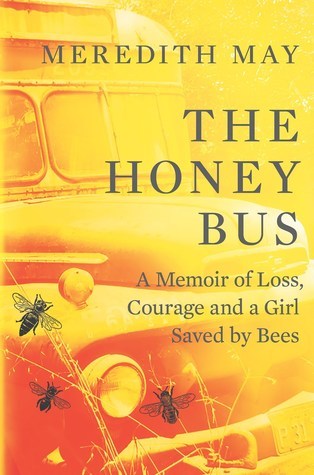 The Honey Bus: A Memoir of Loss, Courage, and A Girl Saved By Bees by Meredith May
The Honey Bus: A Memoir of Loss, Courage, and A Girl Saved By Bees by Meredith MayI think about this book almost daily.
May’s memoir is about growing up in a dysfunctional series of homes and how she came to find beekeeping a way of not only working through her familial challenges but also as a means of finding hope.
When she was young, May’s parents went through a messy divorce following her mother’s outbursts and abuse toward her father. Her mother took her and her brother from their home in Rhode Island to the home of her grandparents in Big Sur, California. Mom disappeared into herself, leaving May and her brother to grow up under the watch of a demanding and unfriendly grandmother and a man that they only ever know as their grandfather — a kind, generous, loving man who had a penchant for beekeeping and encouraged May to join him while he taught her about the ins and outs of the honeybees. This man was not May’s grandfather by blood though; he was a step-grandfather, and the discovery of this unravels into the history of abuse that plagued her family for generations. May’s father never quite reemerges except for one excellent trip back to Rhode Island for her, and her mother becomes more abusive toward her as she grows up. There is a lot of fear and anger throughout the story, but it’s tempered beautifully with the magic of bees and May’s grandfather.
We can’t rank dysfunction, but the level of fear and terror in this memoir isn’t as pronounced as EDUCATED or THE GLASS CASTLE, but readers who find those books to be captivating will find this to be one worth picking up. May’s writing is stunning, and her passion for bees comes through, both in her own voice and in the voice of that unbelievable grandfather in her life.
I grew up in a family that, although not like May’s, was one where I found myself close with my grandfather, too, so this one hit home in a lot of ways. It’s a lovely homage to the people in our lives who give us hope and love, even when we don’t know we need it. Likewise, the naturalist aspects of beekeeping and the incredible power bees have in the world made this bee-lover satisfied. The bulk of this book happens during May’s childhood and teenage years, so it’s totally appropriate for teens who eat up these kinds of true life stories.
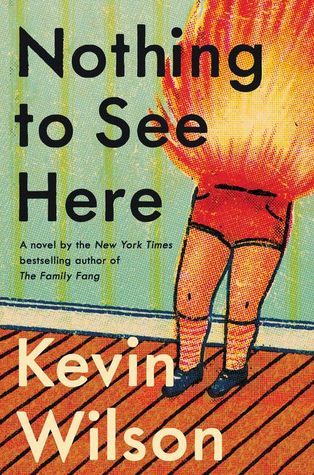 Nothing To See Here by Kevin Wilson
Nothing To See Here by Kevin WilsonThis book absolutely surprised me, and it’s the one I referenced above. I didn’t read it until this month and was blown away by it — and this is one I could not stop listening to on audio, with great credit to Marin Ireland’s performance and spot-on southern accent.
Lillian and Madison went to a private high school together for a short period of time, and when Madison was caught with drugs, Lillian took the fall. She was kicked out of the school, and it further cemented to her what it meant when someone has financial privilege and when someone else doesn’t (she doesn’t). Years later, when Madison offers her a job and security, Lillian takes the opportunity because she wants to get out of the rut that her life has been in since she was young.
That job? Taking care of the children from Madison’s husband’s first marriage. His ex-wife has died, and since he’s running for political office, he needs to present a certain image that those kids don’t project.
Those kids start on fire.
Though this is a book about fire kids (what a hook!), it’s really about class and what privilege can do. It’s also a book about friendship and family, and Lillian is such a complex, compelling, and easy-to-love character, even when she gets prickly. The children are well-drawn and way more than simply kids who have a condition that causes them to become engulfed in flames. It’s heartening, it’s sad, and it’s also quite funny.
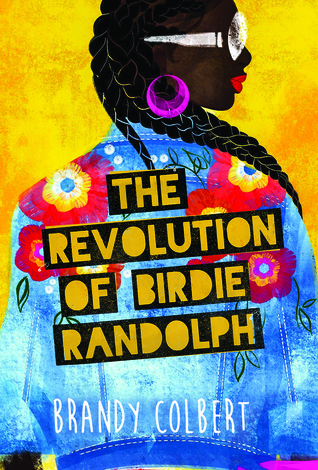 The Revolution of Birdie Randolph by Brandy Colbert
The Revolution of Birdie Randolph by Brandy ColbertMy new tradition to begin every year is to start with a Brandy Colbert book, and I love how even 12 months later, they’re on my mind. It makes me sad that this book seems to have fallen off many reader radars, as it’s maybe her strongest work yet. This is a book about following the rules and breaking them, as well as a book about the family we’re born into and the families that we make along the way.
Birdie’s aunt shows up at her family’s apartment right before the summer begins, and that’s when everything changes; it’s at this same time Birdie is secretly dating a boy she knows her very strict, proper parents wouldn’t like. Despite never pushing boundaries before, these two new people in her life encourage her to take some chances and learn some lessons she never would have on her own.
Colbert depicts her aunt Carlene’s alcoholism with tenderness and offers up the whole range of emotions people experience both as those who are addicts and those who are friends and family of addicts. There is support, but there is also caution exercised around Carlene that showcase hope for her to find recovery but also experience in knowing that this is a disease that is challenging to manage.
The Chicago setting is vibrant and real, and isn’t also afraid to highlight the racial challenges within the city, in terms of violence, racism, and bigotry, and the places and spaces where those do and don’t overlap.
Also handled really fabulously is anger and anger management, recovery from trauma and what that does and doesn’t look like, and it offers such a refreshing perspective on teens, especially teens of color, who’ve been in the juvenile justice system.
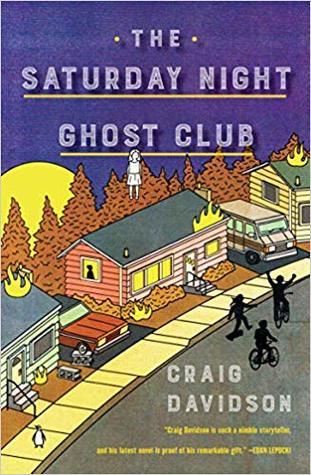 The Saturday Night Ghost Club by Craig Davidson
The Saturday Night Ghost Club by Craig DavidsonThis little book was an absolute surprise to me when I read it, and like the others on this list, it comes back into my mind frequently. Note that in discussing this title, I’ve included the spoiler because that’s ultimately what made this one stand out.
Jake Breaker is a neurosurgeon and he knows how complex the brain can be. The story begins with him talking about the delicacy involved in surgery, and it weaves in the history of one summer in his youth in 1980s Niagara Falls, Canada. He’s been the victim of a vicious bully, which puts him in contact with Billy, the Metis boy who becomes a long-time friend. Over the course of the summer, Jake and Billy, as well as Billy’s older sister Dove (who struggles with bipolar disorder) become close to Jake’s eccentric uncle Cal, who runs an occult store in their small town. Cal suggests that they create a weekly ghost club, taking the lead on treating and terrorizing his nephew and nephew’s friends to stories of the ghosts that haunt their small town. The stories are horrific, though they’re far more about loss and sadness than they are about being scared. They’re stories of death, of people gone missing, of the relics of lives that never got to become what they were meant to be.
But one night, Jake learns that everything his uncle has taught him is simply reconstructed memories from Cal’s own horrific experiencing of losing his wife and unborn child. Cal, who has no recollection of these things, believes these to be ghost stories and not the facts of his own life. Jake wrestles with knowing the truth, both at his youthful age and now, as a neurosurgeon reflecting upon that summer which changed everything he thought he knew.
It’s heartbreaking and heartwarming, as it’s a story about love and loss and the things that we do when we’ve experienced tremendous pains and powerful highs. It’s a short story but one that packs a punch. For readers who are put off by horror, this would make an excellent read in the genre, and the comparisons to Stranger Things and Stand By Me are excellent. It reminded me, too, of the children’s sections of Stephen King’s It, minus Pennywise. This has some great crossover appeal — which isn’t surprising, given that Davidson’s other writing alias has become a Canadian horror writer with huge appeal to teen readers. Gorgeous, poetic, nostalgic writing.
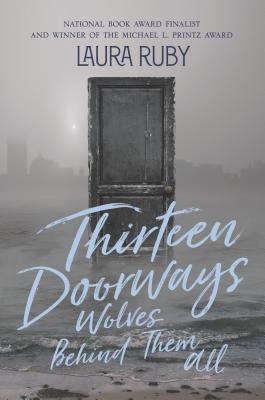 Thirteen Doorways, Wolves Behind Them All by Laura Ruby
Thirteen Doorways, Wolves Behind Them All by Laura RubyI’m not going to talk about this one in depth, in part because I wrote a whole piece about this book over on Book Riot. It’s a tragedy that it did not take home the National Book Award (I don’t think it’s fair to compare books, but I also read 1919, this year’s winner, and I had a number of issues with it that made me wonder why that was the ultimate winner). This was also one of Kimberly’s favorites of the year.
One of the things I started doing this year was dedicating one day a week to writing dates with fellow author Alyssa Wees (her The Waking Forest is a fabulous dark fairy tale, a la Pan’s Labyrinth). As soon as I finished Ruby’s book, I told Alyssa she needed to read it ASAP because I knew she’d love it. I wasn’t wrong, and we spent one of our two-hour dates raving about it.
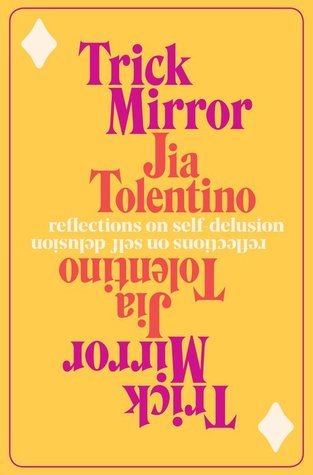 Trick Mirror by Jia Tolentino
Trick Mirror by Jia TolentinoI never would have picked this book up or become an impassioned fan of Tolentino’s writing were it not for a friend who told me to pick this one up and read the first essay about Twitter, since it’d likely articulate a lot of feelings I had about the platform after I chose to leave it. She was right. But more than that, this entire book was an outstanding, challenging, and thoughtful exploration of a number of social and cultural phenomenon explored through the lens of a millennial feminist of color. I told everyone I could to read it, and nearly every one of them also put this book on their favorites list this year. This is a book of meaty, challenging essays that takes time. I read it over the course of months.
I selected this book as my favorite for Book Riot’s Best Books roundup this year. Here’s the short blip I wrote: “Tolentino’s debut essay collection sinks its teeth deep into what it means to be a Millennial in today’s capitalist, hustle-focused culture. Whether it’s Twitter, athleisure, $12 salad lunches consumed at one’s work desk, weddings, or reality TV, each piece shines a feminist lens on what they mean on both the micro and the macro level. Meticulous and critical, Tolentino’s essays challenge readers to think deeply and broadly. This collection is humorous and erudite and offers a sense of relief to fellow Millennials feeling over and under whelmed with the current state of the world.”
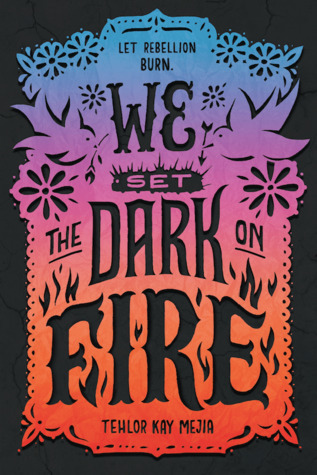 We Set The Dark On Fire by Tehlor Kay Mejia
We Set The Dark On Fire by Tehlor Kay MejiaThe only thing I did not love about this book was that I was half-way through before realizing it was a duology. I felt like salt was added to this wound when I got a package from the publisher not too long ago and there was a publicity one-sheet for the second book but the book itself wasn’t actually in the package (I have it now!).
On the Island, there are the privileged and those who aren’t privileged. But, if you play the system a bit, you can rise above your status and become an elite. This is what happened to Dani, whose parents sacrificed everything for her to attend the Medio School for Girls, where she trained to become a Primera, one of the two wives a man of status takes. She keeps her status as a lower-than-low class girl quiet, and she regrets ever telling Carmen when she believed them to be friends years earlier.
So when Carmen is named the Segunda to her Primera for one of the most powerful men in the country, Dani panics. Can she trust her? How awful will it be living her life with Carmen and this boy forever?
But Dani had been offered something she couldn’t refuse just before the marriage. And it sets her up on a course as a spy from inside the grounds of her new home and not only does it mean defying all of the social mores of her elite status, but it means choosing loyalties. It also means she has to decide whether to harm another girl to get what she needs. Carmen, too, seems to becoming closer and closer to her, too, and Dani becomes more paranoid she’s the target of a ruse.
There’s no secret this book is super queer, and it’s pretty evident from early on who will fall for who. It isn’t a surprise — and it’s really a wonderful relationship. Mejia develops full, round female characters who are caught up in a patriarchal system and choosing to act as they do to not only better themselves, but to also better their sisters. And more, this is a book about class, about borders, and about why it is the elite hate those who are of a lower class than them. It’s about resistance, about power, and about using your voice and your status to make the world better, as opposed to worse.
Compelling, immersive, and beautifully written, this book is feminist as hell, it’s a book that would be perfect to hand to readers who are not necessarily fantasy readers, and those who enjoy mythology, stories of taking down power, and the dynamics of female relationships as they exist in a world meant to keep girls as enemies, rather than as friends or lovers.
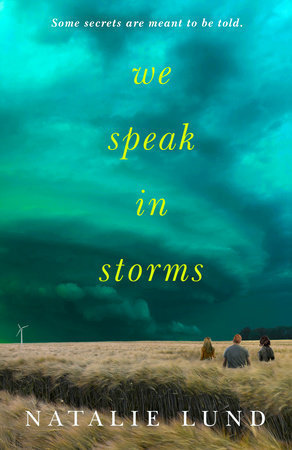 We Speak in Storms by Natalie Lund
We Speak in Storms by Natalie LundGenre-blending books — particularly those which blend ghost stories with contemporary stories — have stood out to me this year. Lund’s debut checked literally every box I have when it comes to books that are catnip for me: it’s about tornadoes, about ghosts, small midwestern towns, and it’s set about 20 miles from where I live (not a necessity, but a bonus, as I could picture so many of these places and could read up on the history of the real events that inspired the book).
Fifty years after Mercer’s infamous, deadly tornado, another tornado rolls through, waking the ghosts of those who died in the first storm. The ghosts become close companions to Callie — currently losing her mother and so much of her stability to cancer; to Joshua — coming out as gay, in a fat body, with a stepfather who won’t accept him at all; and to Brenna — struggling post-breakup to reconcile her Latina heritage with her current life with a single mother in a small town where she’s one of a mere handful of people of color.
Their voices are interwoven with the ghosts, which speak like a Greek chorus.
The language is lush, imagery evocative, and the characters are all rich. This reminded me so much of Jenna Blum’s The Stormchasers, another book I absolutely loved.
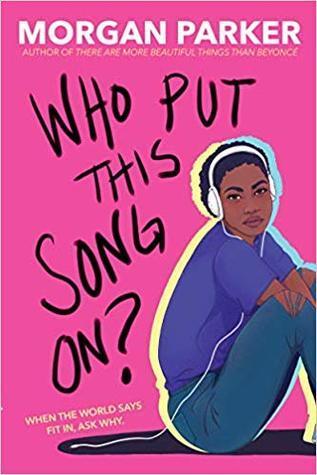 Who Put This Song On? by Morgan Parker
Who Put This Song On? by Morgan ParkerIf there’s a book I can point to on this list and say it was wildly overlooked. . . I could point to a lot, actually. But Parker’s debut YA novel may be at the very top. This book is one of the best depictions of depression and anxiety I’ve read, and it’s especially noteworthy that Morgan, the main character who is based on Morgan the author, is black, as her mental illnesses intersect directly with her experiences being black.
By turns funny and heartbreaking, this book is a slice of life into Morgan’s ups and downs in her conservative Christian school and very white suburban southern California youth. She doesn’t apologize for her experiences, nor feel the need to make excuses for them. She struggles, and it’s honest.
Morgan’s faith plays a big role in the story. She wants to believe in Christianity, but wrestles with what some of the teachings say and how they go against her own beliefs. It’s neatly juxtaposed with how she lays into being an emo kid, despite the fact she is the antithesis of what people believe an “emo” kid to be — white, sad, and covered in eyeliner. She instead loves herself some vintage fashion, is black, and just enjoys (as much as she can!) feeling her feelings to intense music.
One of the criticisms I’ve seen of this book is the thing that makes this such a REAL depiction of depression: Morgan isn’t likable all the time, and she’s not sympathetic all the time. Depression does this. It makes you a monster, even though deep down, you’re hoping to be anything but; we see this tension tugging at Morgan page after page.
The climax of the book is a moment where Morgan puts on a public art performance/activist project and it’s one that really seals the way her mental illness intersects with her blackness, as well as the history of black activism in the United States.
This is one of those books you’ve got to also read through the author’s note and resources. Those are as vital to the story — to Morgan — as every other chapter in the book.
December 19, 2019
This Week at Book Riot
Over on Book Riot this week…
I interviewed Kelly Corrigan and Matt Nathanson about their rad book club Doin’ It In The Nook.
Here’s how YA has changed over the last decade (if you read that Slate piece, this is in response to it).
Add these 2020 literary calendars to your wish list.
December 17, 2019
Best of 2019
As of this writing, I’ve read 88 books in 2019. This year, most of my reading was once again done via audiobook, but it trended toward more adult fiction and nonfiction than it has in the past. This is a list of my top seven reads of 2019, in no particular order.
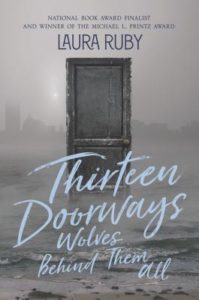 Thirteen Doorways, Wolves Behind Them All by Laura Ruby
Thirteen Doorways, Wolves Behind Them All by Laura RubyI didn’t write an official review for this one, but I loved its 1930s Chicago setting, its dual points of view (one living, one not), and how the many different story threads Ruby wove came together in the end. Check out Kelly’s review at Book Riot for a personal and moving account of this lovely book.
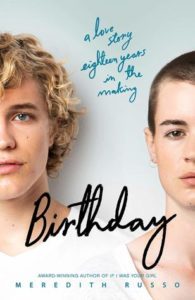 Birthday by Meredith Russo
Birthday by Meredith RussoThe only strictly contemporary realistic novel to make my list, Russo’s sophomore novel is something special. It’s got a great hook: two friends are born on the same day in the same hospital, and each chapter tells of their birthday from 12-18. It’s a friendship story and a romance and, above all, a story about loving people for who they are. It’s a supremely hopeful book that centers a trans teenage girl, and if you loved If I Was Your Girl, you may love this one even more.
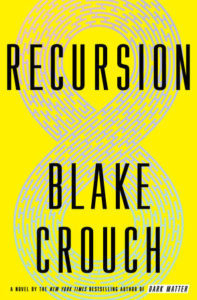 Recursion by Blake Crouch
Recursion by Blake CrouchAs I approached the end of this book, the tension was so high that I had to get up and walk around, the book held open in my hands as I paced in the kitchen. I loved Dark Matter, but Recursion is on a whole other level. It’s a fantastic science fiction thriller for adults that plays with time in a completely unique way. It’s one of those books where so much is going on, and at such a breakneck pace, that a reader may wonder how the author is going to pull it all together – and yet Crouch does in such a satisfying and surprising way. It’s also a deeply thoughtful book, more so than Dark Matter was, and really pushes at the concept of changing the past and what the ultimate consequences would be. I loved this book so much I read it in a single day.
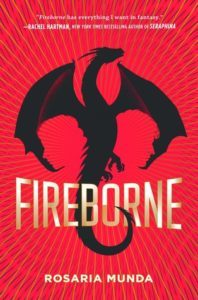 Fireborne by Rosaria Munda
Fireborne by Rosaria MundaYou know I really love a book when my review of it is this long. This is a YA high fantasy based on Plato’s Republic that features dragon riding and dragon fighting, but still manages to feel fresh and unique. It’s about the aftermath of a revolution, and how we build a new, more just society – if that’s even possible. It features two very different leads with different goals but equally impossible choices. It’s full of magic and political intrigue and twists you won’t see coming. You will read this book with your heart in your throat.
 American Kingpin: The Hunt for the Criminal Mastermind Behind the Silk Road by Nick Bilton
American Kingpin: The Hunt for the Criminal Mastermind Behind the Silk Road by Nick BiltonThis year, I discovered a love for true stories about white collar criminals who get busted. This one – about Ross Ulbricht, the 26 year old founder of the Silk Road, a site on the dark web that took advantage of the burgeoning cryptocurrency market to sell illegal drugs, guns, and a myriad of other unsavory things (including murder) – was particularly intriguing to me because Ulbricht grew up in Austin, so I recognized a lot of the references. Bilton connects the dots for his readers, making what could have been an overly complicated tale about a criminal investigation easy to understand, and tells a truly thrilling story (with a happy ending).
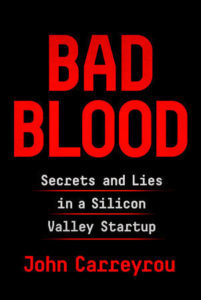 Bad Blood: Secrets and Lies in a Silicon Valley Startup by John Carreyrou
Bad Blood: Secrets and Lies in a Silicon Valley Startup by John CarreyrouThis was the other white collar criminal book I read in 2019 that really fascinated me. I knew very little of what Elizabeth Holmes and Theranos actually did and hadn’t paid much attention to the whole saga while it was ongoing, as big news about medical technology wouldn’t have naturally caught my interest. But Holmes’ story is fascinating, and like Ulbricht’s, demonstrates just how easy it was for these young egotistic criminals to get away with really terrible things for a very long time – and do it in plain view.
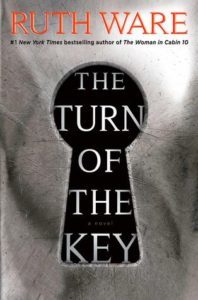 The Turn of the Key by Ruth Ware
The Turn of the Key by Ruth WareRuth Ware is one of my favorite writers, and is definitely my current favorite mystery writer. Her latest is a reworking of The Turn of the Screw by Henry James, complete with a truly creepy setting in a fancy technology-forward smart house gone wrong. Unlike Ware’s previous books, I’d say this one is a bit more of a thriller than a mystery, but I still raced eagerly to the end to see if I was right about whodunnit. And as is usual, Ware still got me with one major twist halfway through.

